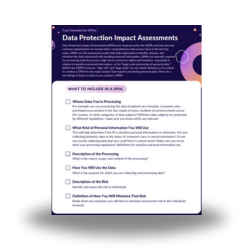Avoid confusion between these two important privacy assessments and learn which is best for protecting your data.
Keeping data and customer personal information (PI) secure is becoming more difficult by the day. Data privacy can feel overwhelming, from complying with new data privacy laws to navigating added risk from third-party vendors.
That’s where intent-driven evaluations like privacy impact assessments (PIAs) and data protection impact assessments (DPIAs) can find and address gaps in your privacy strategy. While both help overcome the complexities of protecting sensitive PI, their distinct focuses and legal contexts set them apart:
- PIAs assess how organizations collect, use, share, and maintain PI to ensure regulatory compliance and address privacy gaps.
- DPIAs analyze privacy risks of processing, using, and storing PI, with a focus on individual rights and freedoms risks.
Understanding the differences between the two is crucial for navigating the complexities of data privacy assessments.
PIAs and DPIAs Are Not the Same
PIAs and DPIAs are often used interchangeably. Notable exceptions include U.S. federal government agencies, which have had a PIA requirement under the eGovernment Act of 2002, and state privacy laws.
What Is a Privacy Impact Assessment?
PIAs act as an internal guide for staying ahead of privacy risks: they help you understand privacy laws and protect sensitive data better than before. As mentioned above, they help organizations determine how they collect, use, share, and maintain personal information.
In addition to filling out PIAs for many U.S. state privacy laws, many organizations use PIAs to evaluate their organization’s investment in privacy protection, including:
- The transparency of privacy notices to guarantee user-informed consent.
- How effective their opt-out mechanisms are for users to fully control their PI.
- Their readiness to respond to data breaches.
E-Government Act of 2002 and PIPEDA Requires PIAs for Federal Entities
The U.S. E-Government Act of 2002 mandates federal agencies to conduct PIAs for information systems that collect, process, or store personal data.
A federal agency must complete a PIA when:
- Developing or procuring any new technologies or systems that handle or collect PI.
- Issuing a new or updated rulemaking that affects PI.
- Developing system revisions.
Similarly, Canada’s Personal Information Protection and Electronic Documents Act (PIPEDA) can require PIAs under certain cases, leading agencies to be more proactive over assessments to mitigate risk. Whether it's implementing a new information system, an update to an existing one, or introducing novel data processing practices, federal agencies must undertake a PIA to assess the potential impact on individual privacy.
The goal is to ensure that government services that manage PI maintain consistent privacy protections and identify and address potential security risks. Every agency is required to provide comprehensive detail into:
- Project or system name, description, and purpose.
- Data collection, including sources, reason for collection, and technologies being used.
- Data attributes, plans for use, and accuracy.
- Sharing practices with internal and external organizations.
- Individual consent for data access and usage.
U.S. State Data Privacy Laws
In addition to federal regulations, U.S. state privacy laws are increasingly imposing PIA requirements to address heightened risk to individuals’ privacy rights. This trend underscores the importance of ensuring that robust processes align with these state-specific requirements for U.S. and global companies.
States such as California and Colorado have enacted comprehensive privacy laws that mandate PIAs when processing PI poses a "heightened risk of harm.” Other states have also implemented similar requirements:
- Connecticut
- Delaware
- New Hampshire
- Florida
- Indiana
- Montana
- New Jersey
- Oregon
- Tennessee
- Texas
- Virginia
Understanding the nuances of state data privacy laws and their respective thresholds for triggering PIAs is crucial for organizations operating in multiple jurisdictions to remain compliant and effectively protect individuals' privacy rights.
What Is a Data Protection Impact Assessment?
On its surface, a DPIA analyzes the privacy risks of processing, using, and storing PI—much like a PIA. However, what separates DPIAs is their legal status as a critical component of GDPR compliance. The regulation mandates DPIAs for processing any data that poses a risk to a person’s rights and freedoms or for specific large-scale processing of personal data.
The EU Requires DPIAs for GDPR Compliance
In the EU, GDPR mandates DPIAs for any data processing that may result in a high risk to individuals. Specifically, the regulation identifies certain types of processing activities that are likely to result in higher risk, including:
- Creating innovative technologies (AI, ML, deep learning models).
- Profiling a large scale of individuals (via social media or fitness/lifestyle monitoring).
- Identifying individuals via biometric data (facial recognition or identity verification).
- Processing of genetic data (such as DNA testing).
- Processing of PI not obtained directly from individual (aka invisible processing).
- Tracking an individual’s geolocation or behavior.
- Targeting children for marketing purposes.
If your organization processes high-risk data, making DPIAs a central piece of your workflow is crucial for ongoing GDPR compliance.
A DPIA is expected to:
- Identify the individuals whose data will be processed.
- Specify the types of personal information to be utilized.
- Provide a detailed description of the processing, including its nature, scope, and context.
- Clarify the purposes for which the processed personal data will be used.
- Evaluate and assess potential risks to the rights and freedoms of the individuals involved.
- Outline proactive measures to minimize and prevent risks to the individuals affected by the data processing.
As with a PIA, it is good practice to conduct a DPIA before any project that involves the processing of PI.
Both DPIAs and PIAs Have Strict, In-Depth Requirements
The stringent requirements imposed by PIAs and DPIAs are not arbitrary; they serve as a foundation for responsible data protection.
Whether it's cyber threats, malware, or unauthorized access, organizations must take steps to ensure long-term security. Thorough assessments act as a proactive strategy to identify, evaluate, and mitigate unavoidable risks of data processing.
Both DPIAs and PIAs can shield organizations from potential legal repercussions such as fines, severe financial penalties, and lawsuits. When data breaches are making headlines and public scrutiny over ethical PI handling is at a fever pitch, assessments also serve as a commitment to customer trust.
And of course, privacy laws and regulations are not static; they evolve in response to technological advancements and societal concerns. Accurate and updated privacy assessments ensure that your business remains adaptable and responsive to changes in the regulatory landscape.
How to Prepare for a Privacy Assessment
To ensure a true, accurate evaluation of your organization’s data practices, you’ll need a well-organized and proactive approach. This will make it easier to overcome challenges throughout the assessment. Asking high-level questions can help guide preparation for a privacy assessment by clarifying key steps in the data process, such as:
- Collection: How will personal information be collected?
- Analysis: What kind of evaluations will be processed using this personalized data?
- Storage: Where and how long will it store that particular set of personal information?
- Distribution/Sharing: To which third-party groups plan to share individual’s private information?
Understanding each component of your existing data management is vital for successful and transparent assessments. While DPIAs and PIAs are different, they share many similarities – especially in how your company should prepare them. Start with these steps:
- Define the scope and objectives of the project, system, or process being assessed. Recognize the sensitivity of PI at risk of being affected and set boundaries to keep the evaluation focused.
- Assemble a cross-functional team to engage with stakeholders across your organization, representing legal, IT, compliance, and operations units. Cross-functional collaboration helps bring diverse perspectives and guarantee clarity throughout the assessment process.
- Map out the data flows within the scope of the assessment and create an inventory log for the PI being collected, processed, and stored to identify privacy gaps and form a basis for risk assessments.
- Identify and classify any personal data being processed. This will help to distinguish between sensitive and non-sensitive information. Use a detailed PIA checklist or ICO guidance to define the nature, scope, context, and purposes of your data processing.
- Conduct a risk assessment to understand the risks associated with current PI processing, such as potential vulnerabilities, impact on individual privacy, and likelihood of occurrence. This step is crucial for both PIAs and DPIAs because it ultimately informs the actions taken during the migration stage.
- Develop mitigation strategies that outline how your organization plans to minimize and prevent the potential risks to individuals’ privacy. This can range from requiring 2FA, improving internal practices, or investing in privacy-focused solutions.
- Thoroughly document the assessment process, including findings, decisions, and actions taken to address identified risks. These records not only serve as an invaluable resource for internal governance but also act as evidence of compliance in the event of regulatory scrutiny.
- Review and update the assessment regularly. The data processing landscape is dynamic, so make plans for continuous monitoring and improvement. Review and adapt the assessment based on evolving risks and changing circumstances. Most importantly, revisit and update the assessment to ensure its ongoing relevance and effectiveness.
You Don’t Need to Conduct Assessments on Your Own
Your internal evaluations don’t have to be solitary. Collaborative efforts and external support can ease your organization's documentation burden.
Rather than risk missing crucial steps or slowing your business down, Osano keeps the PIA and DPIA processes fast and efficient by providing pre-built templates based on standards like ISO and NIST. You can also create custom assessments to fit your organization’s needs.
Book a demo today and learn how Osano can simplify your privacy assessments.
DPIA Template
The GDPR contains plenty of requirements, penalties, obligations, rights, and definitions—but it doesn’t contain a specific template for DPIAs, or data protection impact assessments. So we decided to change that.
Download Your Copy
Osano Staff
Osano Staff
Osano Staff is pseudonym used by team members when authorship may not be relevant. Osanians are a diverse team of free thinkers who enjoy working as part of a distributed team with the common goal of working to make a more transparent internet.
.webp?width=1220&height=1090&name=Osano-guarantee-seal%20(1).webp)



